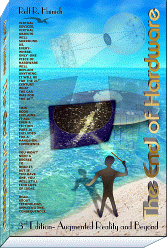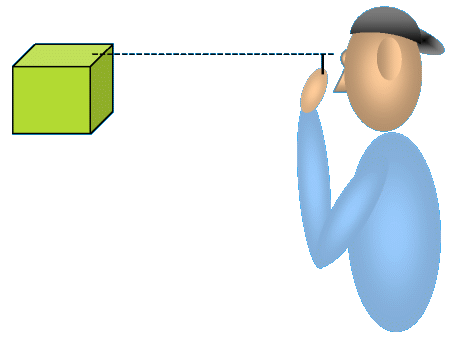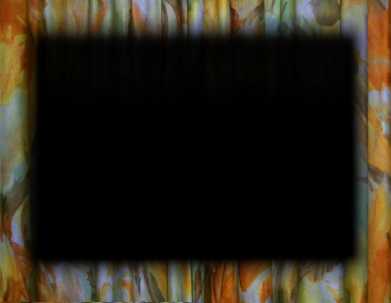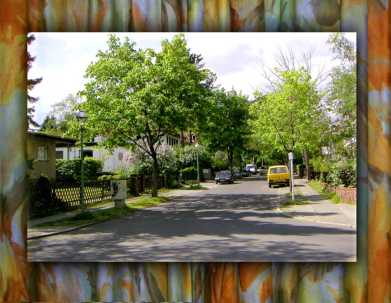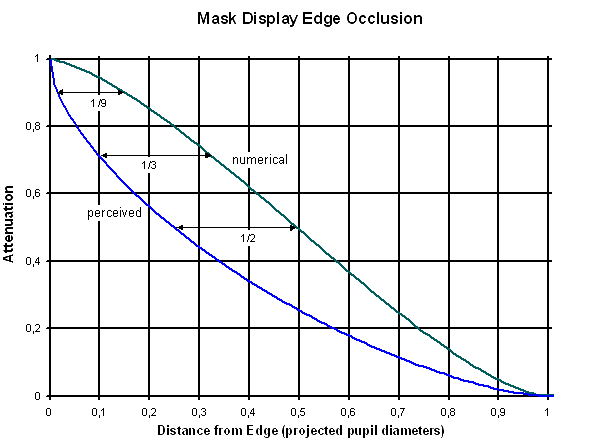Augmented Reality is more than Virtual Reality
Mask displays
Demonstrating the function of the mask display is quite simple: just use a black chip (your thumb would also do for a first try) and move it, 2 cm before the eye, so that it just covers up exactly the edge of some distant object. It may be quite surprising that this results in a pretty sharp edge of total obstruction, even though an area of half transparent shadow remains beneath it. Use some thin masking object to verify that even tiny distant objects could be cut out quite selectively. The size also depends on your actual pupil diameter. A real mask display would have to be corrected for this, and also for edge diffraction effects.
In this example, the (naturally unsharp) masking is applied on a natural background. This can be done with a simple LCD display close to the eye, for example. Even transparent active driver circuits for these have been demonstrated recently. Finding a display type with higher transmission rates is still a challenge, but it will be solved, and the LCD version is already good for most applications.
Now we have inserted a picture into the mask frame. Quite obviously, the masking process is hardly visible. The fuzziness of the mask is not a major issue at all. We should note that this fuzziness is mainly caused by the non zero pupil diameter, not by edge diffraction. If the background texture is known (by the position cameras for example) we could even partly compensate it by modifying the picture's edges.
Why is this unsharp masking so little visible? Assuming a pupil diameter of 1.5 mm for example (typical for office light levels), and a distance from eye to mask display of 30 mm, the unsharp border at 3 m distance could - at a first glance - extend up to 15 cm.
The eye however has an extremely logarithmic brightness perception. As any photographer should know, an "average gray" reference card has a reflection factor of only 20% but is perceived as about 50% gray. Taking this into account, we get the following visual edge characteristics:We see that for attenuations between 50 and 90%, the perceived edge width is between 2 and 9 (!) times smaller than expected. At 3 m distance, we would therefore get an edge of only 1.5 cm, where subjectively 30% of the background brightness is already shining through. In case of a virtual computer monitor or other device just 40 cm away, this edge is only 2 mm.
Hence, the astonishingly small visual edge blur of our mask display is easily explained.The mask display is only one of the essentials for good display glasses, but a crucial one.
home more notes order
Copyright © 2006-2011 Rolf R. Hainich; all materials on this website are copyrighted.
Disclaimer: All proprietary names and product names mentioned are trademarks or registered trademarks of their respective owners. We do not imply that any of the technologies or ideas described or mentioned herein are free of patent or other rights of ourselves or others. We do also not take any responsibility or guarantee for the correctness or legal status of any information in this book or this website or any documents or links mentioned herein and do not encourage or recommend any use of it. You may use the information presented herein at your own risk and responsibility only. To the best of our knowledge and belief no trademark or copyright infringement exists in these materials. In the fiction part of the book, the sketches, and anything printed in special typefaces, names, companies, cities, and countries are used fictitiously for the purpose of illustrating examples, and any resemblance to actual persons, living or dead, organizations, business establishments, events, or locales is entirely coincidental. If you have any questions or objections, please contact us immediately. "We" in all above terms comprises the publisher as well as the author. If you intend to use any of the ideas mentioned in the book or this website, please do your own research and patent research and contact the author.
